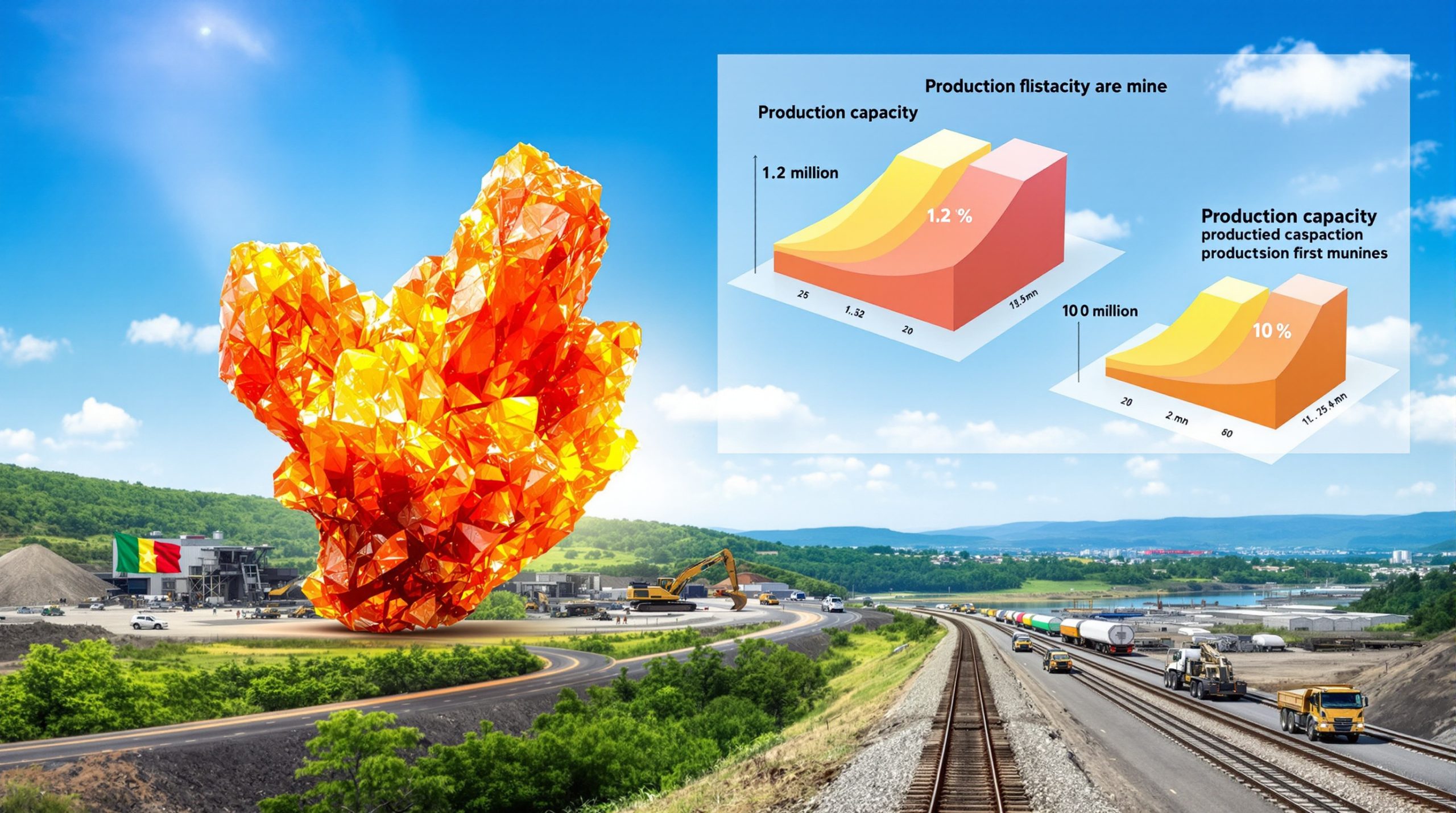The Pentagon's Strategic $500 Million Cobalt Acquisition Plan
The United States Department of Defense, in collaboration with the Defense Logistics Agency (DLA), has launched an ambitious procurement program targeting alloy-grade cobalt with a potential investment reaching $500 million over five years. This initiative aims to secure approximately 7,480 tonnes of this critical mineral to strengthen national defense stockpiles and address growing concerns about supply chain vulnerabilities.
The procurement plan reflects broader national security priorities, with contracts ranging from $2 million to the full $500 million allocation across the five-year period. Perhaps most notably, the Pentagon has restricted eligible suppliers to just three companies: Vale in Canada, Sumitomo Metal Mining in Japan, and Glencore Nikkelverk in Norway—a clear indication of the strategic importance placed on securing cobalt from trusted allies.
Why Cobalt Has Become a National Security Priority
Cobalt has emerged as a cornerstone material for modern defense systems due to its unique properties and versatility. The metal plays a crucial role in multiple defense applications, making it indispensable for military readiness and technological superiority.
At the heart of cobalt's strategic importance is its integral role in battery technology, which powers an increasing array of military equipment from tactical radios to unmanned vehicles. The metal's exceptional performance in high-temperature environments also makes it essential for superalloys used in jet engines and gas turbines that power military aircraft and vessels.
Beyond these applications, cobalt's magnetic properties contribute to radar systems, precision-guided munitions, and communications equipment—all fundamental components of modern defence capabilities. As warfare becomes increasingly technology-dependent, securing reliable cobalt project expansion becomes proportionally more critical to maintaining military advantages.
Military experts point to cobalt's role in enhancing operational resilience. Unlike some alternative materials, cobalt-containing components can withstand extreme environments, from arctic cold to desert heat, ensuring equipment functions reliably in diverse deployment scenarios.
Integration With America's Critical Minerals Strategy
The Pentagon's cobalt procurement initiative represents one component of a comprehensive national approach to securing critical minerals essential for both defense and economic security. This strategy has gained renewed emphasis following recent global supply chain disruptions.
Recent policy developments underscore this priority. Trump's critical minerals order aimed at bolstering U.S. mineral production specifically targets reducing foreign dependence and strengthening national security. The appointment of David Copley, a former mining executive, to lead the National Security Council's office dedicated to supply chain resilience signals the administration's commitment to addressing vulnerabilities.
The Department of Interior under Secretary Doug Burgum has taken what officials describe as "decisive" steps to extract critical minerals from mine waste, including prioritizing uranium recovery and directing the U.S. Geological Survey to map and catalogue federal mine waste sites. These initiatives reflect a growing recognition that domestic resource utilization must be maximized to reduce reliance on potentially unstable foreign suppliers.
China's recent restrictions on rare earth exports, which led to a significant downturn in rare-earth magnet exports and subsequent production halts at some automotive companies, have added urgency to the critical minerals strategy. These disruptions demonstrate how mineral supply chains can quickly become geopolitical leverage points, affecting both military readiness and economic stability.
Economic Dimensions of the Pentagon's Cobalt Initiative
The $500 million cobalt acquisition represents significant economic activity with implications extending beyond defense applications. This substantial government investment sends powerful signals to markets and supply chains that have historically operated with limited domestic focus.
Market Impact Considerations
Government procurement on this scale may influence global cobalt pricing, potentially stabilizing markets that have experienced significant volatility in recent years. The five-year commitment provides predictability that could encourage long-term investment in production capacity, particularly among North American and allied nation suppliers.
For commercial sectors that rely on cobalt—including electric vehicle manufacturers, electronics producers, and aerospace companies—the defense initiative may create both challenges and opportunities. While competition for limited supplies could potentially increase input costs, the investment in supply chain development could ultimately benefit all cobalt consumers by expanding and diversifying global production.
The exclusive supplier arrangement with companies in Canada, Japan, and Norway reflects strategic prioritization of allied nations in critical mineral supply chains. This approach aligns with broader efforts to develop "friendly shore" supply networks that reduce vulnerabilities to geopolitical tensions or economic coercion.
"Strategic materials procurement isn't just about warehousing materials—it's about cultivating supply relationships that can adapt and scale during crises," notes former Defense Production Act committee member Dr. Rebecca Harding in her analysis of critical mineral strategies.
Global Cobalt Supply Chain Complexities
Understanding the global cobalt landscape provides essential context for the Pentagon's procurement strategy and highlights the challenges in securing reliable supplies.
Production Concentration and Vulnerabilities
The global cobalt supply chain exhibits extreme geographic concentration, with the Democratic Republic of Congo (DRC) accounting for approximately 70% of worldwide production according to U.S. Geological Survey data. This concentration creates inherent vulnerabilities, as political instability, labor issues, or export restrictions from a single region can significantly impact global availability.
Further complicating the supply picture is China's dominance in cobalt processing. Despite limited domestic cobalt mining, Chinese refineries process the majority of global cobalt, creating a critical supply chain bottleneck. This processing concentration compounds risks associated with production concentration.
Ethical sourcing concerns also affect the cobalt market, particularly regarding labor practices in some DRC mining operations. Defense procurement programs must navigate these complexities while ensuring compliance with responsible sourcing requirements.
Alternative Supply Development Initiatives
The Pentagon's focus on North American and European suppliers aligns with broader efforts to develop alternative cobalt sources. Several promising developments may reshape supply chains in coming years:
- North American projects in Idaho, Ontario, and Quebec are advancing toward production
- Australian operations continue expanding production capacity from politically stable jurisdictions
- Battery recycling initiatives are improving cobalt recovery rates from end-of-life products
- Deep‐sea cobalt exploration continues evaluating oceanic cobalt nodules as potential future sources
Technological Factors Influencing Future Defense Cobalt Requirements
The Pentagon's cobalt strategy must account for evolving technologies that could affect future requirements, creating both challenges and opportunities.
Emerging Technologies and Material Efficiency
Battery chemistry research continues seeking ways to reduce cobalt intensity while maintaining performance. Several manufacturers have already decreased cobalt content in lithium-ion batteries, potentially reducing per-unit cobalt requirements. However, the explosive growth in battery metals investment insights may offset efficiency gains with volume increases.
Advanced manufacturing techniques are also improving material utilization efficiency. Additive manufacturing processes can reduce waste compared to traditional subtractive methods, potentially decreasing overall cobalt requirements for some components.
Defense researchers continue investigating alternative materials that could potentially substitute for cobalt in certain applications. However, the unique properties that make cobalt valuable in defense systems—heat resistance, magnetic characteristics, and durability—have proven difficult to fully replicate with substitute materials.
Geopolitical Considerations in Mineral Security
The cobalt procurement initiative exists within a complex geopolitical landscape where resource access increasingly influences international relations and security planning.
China's export restrictions on rare earth minerals in 2025 demonstrated how mineral access can quickly become a geopolitical tool. This action prompted production disruptions across multiple industries and highlighted vulnerabilities in supply chains previously considered secure.
Resource nationalism—where producer nations implement export restrictions, nationalize mining operations, or impose higher royalties—continues affecting mineral markets globally. Countries increasingly view critical minerals as strategic assets rather than purely commercial commodities.
International competition for mineral resources has intensified as nations recognize their importance for both economic and defense applications. Several countries have established strategic reserves similar to the US defense department purchase $500m cobalt, potentially increasing competition for limited supplies.
Answers to Common Questions About the Pentagon's Cobalt Strategy
Why is the U.S. government investing in cobalt stockpiles now?
The timing reflects growing recognition of supply vulnerabilities exposed by recent disruptions. China's export restrictions on rare earth minerals demonstrated how quickly supply chains can be weaponized for geopolitical leverage. Additionally, forecasted demand growth—driven by electrification across military and civilian sectors—suggests potential supply constraints ahead without proactive measures.
The Pentagon's approach indicates a shift from just-in-time supply chain models toward strategic stockpiling for critical materials where substitutes are limited and production is concentrated in potentially unreliable regions.
How does this cobalt procurement compare to historical defense stockpiling?
While the U.S. has maintained strategic material reserves since World War II through the National Defense Stockpile, this $500 million cobalt initiative represents a targeted response to specific 21st-century threats. Historical stockpiling focused primarily on wartime production capacity, while current efforts increasingly address complex supply chain risks including processing bottlenecks, technological dependencies, and geopolitical vulnerabilities.
The focus on specific suppliers from allied nations also differs from historical approaches that often emphasized raw material quantities without necessarily addressing processing capabilities or supply chain resilience.
Will this procurement affect commercial cobalt availability?
The 7,480 tonnes targeted by the Pentagon represents a significant but manageable portion of global production. The five-year acquisition timeline should allow suppliers to adjust production planning, minimizing market disruption. However, commercial sectors may experience some near-term pricing pressures, particularly if acquisition coincides with increased commercial demand from electric vehicle manufacturing or other battery-intensive industries.
For context, a typical electric vehicle battery contains approximately 5-10 kg of cobalt (depending on chemistry), meaning the Pentagon's total procurement over five years would equal the cobalt needed for roughly 750,000 to 1.5 million electric vehicles—a material but not market-dominating quantity.
How does this initiative support domestic mining?
Although current procurement focuses on established international suppliers, the long-term signal of government demand may encourage investment in developing North American cobalt resources. Several domestic projects in Idaho could benefit from increased market confidence in future demand.
The Department of Interior's initiatives to recover critical minerals from mine waste could provide additional domestic cobalt sources if commercially viable extraction methods are developed. Historical mining operations often focused on single commodities, leaving associated minerals like cobalt in waste piles that could now become valuable resources with advanced processing techniques.
Future Outlook for Defense Mineral Security
The Pentagon's cobalt initiative likely represents just one component of a comprehensive approach to mineral security that will continue evolving in response to technological, geopolitical, and market developments.
Defense planners increasingly view mineral security through a systems perspective that addresses the entire supply chain from mining through processing to manufacturing. This holistic approach recognizes that having access to raw materials provides limited security if processing capabilities remain concentrated in potentially unreliable regions.
As technologies evolve, mineral requirements will shift accordingly. The defense sector's increasing reliance on advanced batteries, electronics, and sophisticated materials means mineral security planning must remain adaptable rather than static.
The national security implications of US defense department purchase $500m cobalt extend beyond direct defense applications to encompass economic security, technological leadership, and strategic independence. Future mineral security strategies will likely continue blending stockpiling, domestic production incentives, recycling initiatives, and international supply agreements to create multilayered resilience.
Disclaimer: This article contains analysis of defense procurement strategies and mineral markets that necessarily involve some speculation about future trends and impacts. Readers should consult official government sources for definitive information about defense procurement programs and consult qualified investment advisors before making decisions based on market analysis presented here.
Want to Catch the Next Major Mineral Discovery?
Don't miss significant ASX mineral discoveries that could transform your portfolio. Visit Discovery Alert's discoveries page to see how their proprietary Discovery IQ model delivers real-time alerts on emerging opportunities, giving you the crucial market edge before the crowd catches on.




